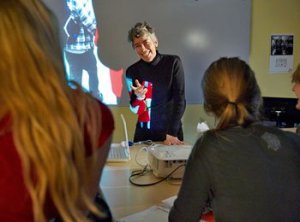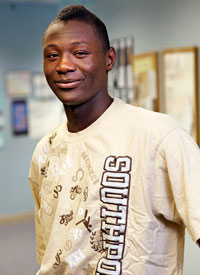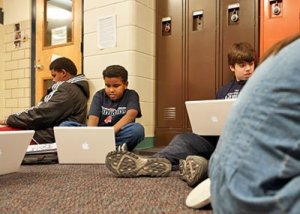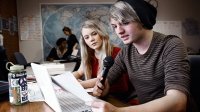Project Learning Meets Technology
By giving every middle school student a new laptop, the state of Maine strapped new wings on project learning. For both teachers and students, the learning process has soared beyond the classroom.
When Yuki Hall finally arrived at Casco Bay High School last September, she wasn't expecting perfection. Anything other than alienation would be an improvement from her experience at her previous school. She figured there would be the usual high school anxieties and dramas. Nevertheless, the doe-eyed 17-year-old was counting down the days. She had already shadowed at Casco Bay -- followed students through a typical day -- and, to her own surprise, loved it.
Hall transferred to this small, 248-student high school in Portland, Maine, at the start of her junior year. Now, she says, that feeling of being a red jelly bean in a box of green ones is gone. "For me, going to Casco Bay each day is like Harry Potter going to Hogwarts. It fits. It's me. I am excited to go to school every day. I wake up and I jump out of bed because of how happy I am to be here."
Casco Bay was the first new high school in Portland in 150 years when it opened in 2005. The timing was serendipitous. Three years earlier, then-governor Angus King launched a $41 million initiative to put laptop computers in the hands of every middle school student and teacher in the state. When Casco Bay opened, it received a grant to purchase used laptops that had been returned by middle schools, such as Helen King Middle School, a few miles away. Last year, the state of Maine officially extended the program, allowing high schools to buy new laptops, though they'd have to pay for them out of their school technology budget.
Expeditionary Learning
Casco Bay benefited from more than King Middle School's hand-me-down computers. The high school was designed around a variation on project-based learning that King helped pioneer. (Watch the 2013 PBS NewsHour report on PBL at King Middle School.) It's called expeditionary learning, and it builds on the collaborative, interdisciplinary approach of project learning, then extends the effort out of the classroom into the community. Past assignments have included creating public-service announcements on energy efficiency for local broadcasts, raising awareness of the dangers of cell phone use while driving, and designing playground equipment for preschool children.
The galvanizing element is technology. Nearly every school in the country is now wired for computers, but few have taken it to the scale you see in Maine. "I can't imagine designing the curriculum that I do without being able to click onto the Internet and get all the materials and resources that are available, and I can't imagine my students not being able to do that either," says humanities and English teacher Susan McCray.

Her short gray hair is deceptive; McCray is definitely not a member of the old-school way of doing things. An avid outdoorswoman, she laughs easily and frequently, speaks with passion, and shuns textbooks. "We live in an age where you can't get away with just giving kids information, because they already have at their fingertips almost all the information that exists in the universe."
The beauty of expeditionary projects is that when set up properly, they can be more relevant and engaging than regular schoolwork. On a cold, windy December afternoon, McCray sat with three of her pupils in a modest but comfortable living room in Logan Place, a newly constructed apartment complex that provides homeless people a permanent place to live. A few feet away, on a small quilt-covered couch, Rose and her neighbor Ed, wearing years of street survival on their faces, answered questions about their lives.
As Ed told students what it was like to sleep in his car in the Wal-Mart parking lot, 16-year-old Abdelghani Ahmed, whose family fled the Sudan nearly seven years ago, took notes. Later on, he and his classmates would create narrated multimedia slide shows on their laptops to be exhibited at a gallery in downtown Portland. The audience would include Rose and Ed and the other homeless people interviewed by the students.
Skeptics have charged that such projects are not academically rigorous. McCray rejects the criticism. "It's not just about, 'Oh cool, we have a tool and we can make cool stuff,'" she says. Students must familiarize themselves with public policy, economics, literature, creative writing, and history to complete the project. She notes, too, that the junior class will soon expand the homeless project in Portland by traveling to Appalachia to help build affordable housing with Habitat for Humanity.
Not Your Average New England Town
Portland itself is a place where the old ways have undergone radical changes. The city is a primary resettlement region for Catholic Charities, which, during the past 35 years, has brought more than 5,000 refugees to this predominately white city of 64,000. That's how Abde (as his classmates call him) and his family found themselves in Maine five years ago, after escaping Sudan, a place where he says he didn't feel safe even when he was in school. "It was pretty much either you do your homework or you get beaten. You pay attention in class or you get beaten," he says. "You would go to school and come back with marks all over your back."

About a quarter of Casco Bay's students are kids of color, the majority first-generation African Americans. Almost half the students receive free or reduced-price lunch, and 16 percent are English learners, primarily Sudanese and Somali refugees.
Abde, a tall and dark-skinned student with a keen sense of humor, says despite all that he has been through, he was stirred by the homeless project. "It changed my perspective of life," he explains. "I appreciate what I have and what my family has done for me."
A Middle School Breakthrough
Both Abde and McCray came to Casco Bay from King Middle School -- the nearby early convert to expeditionary learning. The King Middle School of today was unrecognizable 22 years ago, when Mike McCarthy arrived to take over as principal. He found kids fighting in the corridors, poor attendance, seven layers of academic tracking that placed students in classes ranging from college bound to vocational to disregarded -- mostly along racial and socioeconomic lines -- and a disheartened teaching staff.
As someone who grew up in a quintessential Irish Catholic neighborhood of Boston, McCarthy didn't shy away from challenges. One of the first things he did at King was to eliminate academic tracking. Within a year, teachers who weren't interested in changing their approach were either urged to leave or fired. McCarthy knew he had a small window of time to transform the school's culture and, after doing some research, he decided on the first step toward building the trust and teamwork he would need to succeed. He would take a core group of five teachers on an Outward Bound course.
What impressed McCarthy was Outward Bound's essential commitment to getting everyone to the top of the mountain or safely through the rapids. "When you are navigating dangerous waters in a raft, the only way to succeed is for everyone to sit out on the edge of the raft and paddle really hard even though you'd rather be sitting in the center, where it's safer." That's what he wanted for King Middle School at this pivotal moment: all paddles in the water. The course worked. The next summer, he took 15 people and then another 15 the year after that.
"So now, we began to have a serious-sized group of people who were saying, 'How do we bring this kind of commitment into school?'" McCarthy says. And, in one of those rare serendipitous moments when the stars align, the folks at Outward Bound were asking themselves the same question: How could they adapt their skill and community-building program for schools?
Susan McCray was one of those Outward Bound insiders. In 1993, Outward Bound launched its expeditionary learning program at ten schools. King was one of them. When Maine's one-to-one laptop program for middle schools came along nine years later, King was primed to elevate its already innovative curriculum to a new level. McCray joined the King faculty a year later, after earning her master's degree in education at Harvard and working at a school in Cambridge.
These days, King Middle School receives so many requests from educators and policy makers to tour and learn about its program that the school has developed a visitors' workshop and charges a registration fee.
Not Your Average New England Classroom

It's clear just from walking through the school that something different is happening here. In most schools, students found in the hallways during class get a one-way ticket to the principal's office. At King, the hallways are animated with small clusters of kids sitting outside their classrooms, quietly working on group projects. Inside the classrooms, seventh graders are learning to grow bacteria and then find the best way to kill it. (UV light beat those antibiotic hand sanitizers.)
"My goal is to make a tough topic fun, simplifying it without denuding it of meaning," says science teacher Ruth MacLean. The bacteria project was critical for teaching students about life cycles.
MacLean called a former professor at the University of Southern Maine, just down the street, and arranged for the students to tour the school's transmission electron microscope, normally off-limits to visitors. (A high-powered microscope that cost $200,000 -- it works by focusing a beam of electrons through an object.) The scientists who use the instrument later came to the school to review the students' work with them.
The kids were wide-eyed and rapt as they donned protective lab coats, goggles, and purple gloves to tour the microscope facility. They learned how to set up an agar plate (agar is a gelatinous substance made from red algae used to grow stuff in a petri dish) and create a colony of bacteria. MacLean moved about the room answering questions and checking in with the students. "How's it going?" she asked a reserved boy named Noah. He looked up at her, filled with excitement she'd never seen in him before and said, "Man! I want to work in a lab as a grown-up."
The project couldn't have been done without the laptops and Internet connection. Most of what's written about bacteria in textbooks is way over students' heads, according to MacLean; in fact, it's way over just about everyone's heads except for scientists. But the Web is different; it's everyman's encyclopedia. "I gave them specific questions to look up," says MacLean, noting that she had already searched to make sure the answers were there and were understandable and accurate. "They could open their laptops and get it right then, and I would move on to the next activity."
While the students were researching their bacteria with MacLean, King's scientific communications teacher -- the person who brings the technology component of each project to life -- taught them how to create comic strips online. The students transformed their bacteria into single-celled superheroes using the comic strip format and designed pamphlets about how their bacteria help make soil nutrient-rich. Then they distributed the pamphlets at garden- and farm-supply centers to spread the word about which bacteria are critical to the life cycle.
Projects at King switch between math and science one semester and humanities and social studies the next. Any teacher may pitch an idea, but it requires a team to make it happen. At King, these teams are called houses. MacLean's house is Windsor 7. It's made up of five core teachers, a special-ed teacher, a guidance counselor, an English-learner teacher, and 82 students who remain together for two years.
In this way, teachers come to know their students' learning styles, strengths, and weaknesses, and discuss as a group how to work with each child.
What separates King Middle School's program from most others is team and time. In each house, teachers get about two-and-a-half hours a week to work collaboratively. That's in addition to a similar amount of prep time for each teacher individually. While the teachers are meeting, their students are in enrichment classes like art, PE, or music.
Assessment To Understand Success
According to David Silvernail, director of the Center for Education Policy, Applied Research, and Evaluation, it's no surprise that King Middle School remains an anomaly, even in Maine. Speaking of the state's laptop program, he says, "there's an unevenness in implementation statewide." Silvernail has been studying the laptop program since its inception. He says the program was rolled out so quickly back in 2002 that state officials never developed a common set of standards and practices for how schools should use the computers. "As a result, there are 225 middle schools and 240 different implementation plans," Silvernail says.
The laptop idea, says Silvernail, was sold to the state legislature as a way to raise test scores. But, he says, even though King Middle School and Casco Bay High School score above the state average on standardized tests, there's no way to know how much of that success is due to the laptops, the expeditionary learning, the collaboration among teachers, or something else entirely.
When coupled with professional development, the one-to-one laptop program demonstrably improves student learning. But the amount of instruction that teachers receive is also lopsided. The state offers webinars and a training staff, but not all schools make use of them.
Teachers As Models For Students
Claire Hall, whose daughter Yuki transferred to Casco Bay her junior year, says, "the thing that strikes me more and more is that Casco Bay provides education as it should be, and these are things all schools should do." The teachers model the behavior and values they expect students to live by, they're supportive and kind to each other, and they set reasonable expectations.
Hall doesn't even want to think about what would have happened if Yuki had to remain in her former school. "It had to end," she says, adding that her daughter was beaten down by a traditional high school that had no tools for accommodating Yuki's learning style, which tends toward hands-on learning rather than memorization. "There was just a sadness that was settling in."
Several years ago, after accompanying her father on a business trip to Japan, Yuki decided to teach herself Japanese. At her former high school, classmates and teachers chalked it up as another reason to view Yuki as an oddity. But at Casco Bay, everyone is accepted as they are.
Yuki has thrived at the school. In just one semester, she's regained her confidence and joy, her grades have improved, and she's learning subjects she never thought she could master, like math.
She celebrated her newfound happiness by changing her name. Her parents named her Chelsea, but after studying Japanese, she chose Yuki, which means courage.
